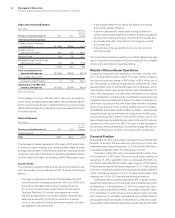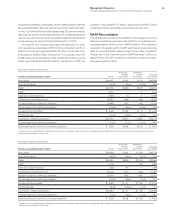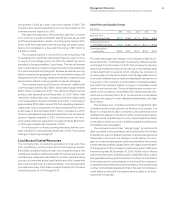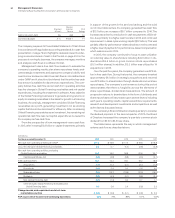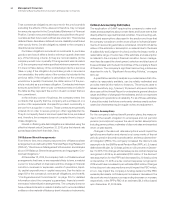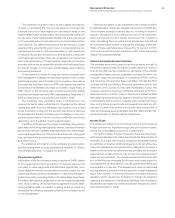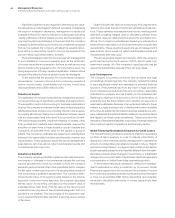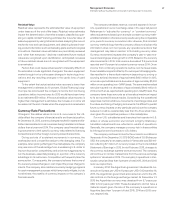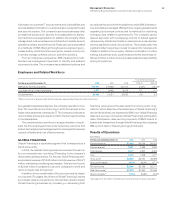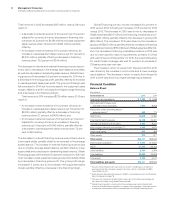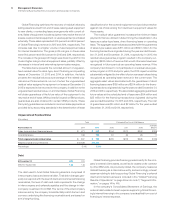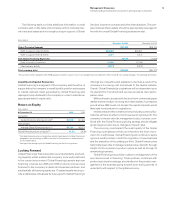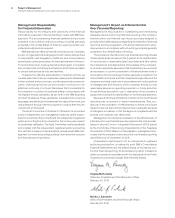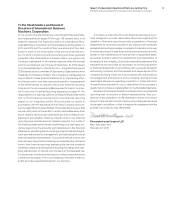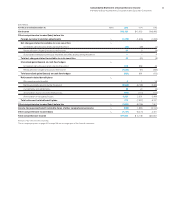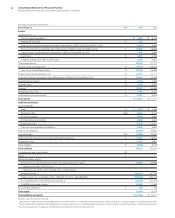IBM 2015 Annual Report Download - page 70
Download and view the complete annual report
Please find page 70 of the 2015 IBM annual report below. You can navigate through the pages in the report by either clicking on the pages listed below, or by using the keyword search tool below to find specific information within the annual report.68 Management Discussion
International Business Machines Corporation and Subsidiary Companies
Market Risk
In the normal course of business, the financial position of the com-
pany is routinely subject to a variety of risks. In addition to the
market risk associated with interest rate and currency movements
on outstanding debt and non-U.S. dollar denominated assets and
liabilities, other examples of risk include collectibility of accounts
receivable and recoverability of residual values on leased assets.
The company regularly assesses these risks and has estab-
lished policies and business practices to protect against the
adverse effects of these and other potential exposures. As a
result, the company does not anticipate any material losses from
these risks.
The company’s debt, in support of the Global Financing busi-
ness and the geographic breadth of the company’s operations,
contains an element of market risk from changes in interest and
currency rates. The company manages this risk, in part, through
the use of a variety of financial instruments including derivatives, as
described in noteD, “Financial Instruments—Derivative Financial
Instruments,” on pages 101 through 105.
To meet disclosure requirements, the company performs a
sensitivity analysis to determine the effects that market risk expo-
sures may have on the fair values of the company’s debt and other
financial instruments.
The financial instruments that are included in the sensitivity
analysis are comprised of the company’s cash and cash equiv-
alents, marketable securities, short-term and long-term loans,
commercial financing and installment payment receivables,
investments, long-term and short-term debt and derivative finan-
cial instruments. The company’s derivative financial instruments
generally include interest rate swaps, foreign currency swaps and
forward contracts.
To perform the sensitivity analysis, the company assesses
the risk of loss in fair values from the effect of hypothetical
changes in interest rates and foreign currency exchange rates
on market-sensitive instruments. The market values for interest
and foreign currency exchange risk are computed based on the
present value of future cash flows as affected by the changes
in rates that are attributable to the market risk being measured.
The discount rates used for the present value computations were
selected based on market interest and foreign currency exchange
rates in effect at December31, 2015 and 2014. The differences in
this comparison are the hypothetical gains or losses associated
with each type of risk.
Information provided by the sensitivity analysis does not neces-
sarily represent the actual changes in fair value that the company
would incur under normal market conditions because, due to prac-
tical limitations, all variables other than the specific market risk
factor are held constant. In addition, the results of the model are
constrained by the fact that certain items are specifically excluded
from the analysis, while the financial instruments relating to the
financing or hedging of those items are included by definition.
Excluded items include short-term and long-term receivables
from sales-type and direct financing leases, forecasted foreign
currency cash flows and the company’s net investment in foreign
operations. As a consequence, reported changes in the values
of some of the financial instruments impacting the results of the
sensitivity analysis are not matched with the offsetting changes
in the values of the items that those instruments are designed to
finance or hedge.
The results of the sensitivity analysis at December31, 2015 and
2014, are as follows:
Interest Rate Risk
At December31, 2015, a 10percent decrease in the levels of inter-
est rates with all other variables held constant would result in a
decrease in the fair value of the company’s financial instruments of
$69million as compared with a decrease of $123million at Decem-
ber31, 2014. A 10percent increase in the levels of interest rates
with all other variables held constant would result in an increase in
the fair value of the company’s financial instruments of $66million
as compared to an increase of $119million at December31, 2014.
Changes in the relative sensitivity of the fair value of the company’s
financial instrument portfolio for these theoretical changes in the
level of interest rates are primarily driven by changes in the com-
pany’s debt maturities, interest rate profile and amount.
Foreign Currency Exchange Rate Risk
At December31, 2015, a 10percent weaker U.S. dollar against for-
eign currencies, with all other variables held constant, would result
in a decrease in the fair value of the company’s financial instru-
ments of $74million as compared with an increase of $872million
at December31, 2014. Conversely, a 10percent stronger U.S. dollar
against foreign currencies, with all other variables held constant,
would result in an increase in the fair value of the company’s
financial instruments of $74million compared with a decrease of
$872million at December31, 2014.
Financing Risks
See the “Description of Business” on page27 for a discussion of
the financing risks associated with the Global Financing business
and management’s actions to mitigate such risks.
Cybersecurity
The company’s approach to cybersecurity draws on the depth
and breadth of its global capabilities, both in terms of its offer-
ings to clients and its internal approaches to risk management.
The company has commercial solutions that deliver identity
and access management, data security, application security,
network security and endpoint security. IBM’s solutions include
security intelligence, analytics and forensic tools that can collect


